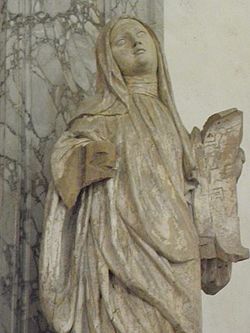Burgundofara

Saint Burgundofara | |
|---|---|
 | |
| Died | 643 or 655 |
| Venerated in | Roman Catholic Church Eastern Orthodox Church |
| Feast | 3 April;[1] at Faremoutiers, she was commemorated on 7 December. She continues to be commemorated on 7 December in the Orthodox Church. |
Burgundofara (died 643 or 655), also Saint Fara or Fare, was the founder and first abbess of the Abbey of Faremoutiers.
Life
[edit]Her family is known as the Faronids, named after her brother Faro. Her name may mean "she who moves the Burgundians".

Jonas of Bobbio's life of Columbanus reports that she was blessed by the Irish monk when a child:
Then Columban went to the city of Meaux. There he was received with great joy by a nobleman Hagneric (Chagneric, father of Burgundofara), who was a friend of Theudebert [King Theudebert II], a wise man, and a counsellor grateful to the king, and was fortified by nobility and wisdom. ... Columban blessed his house and consecrated to the Lord his daughter Burgundofara, who was still a child, and of whom we shall speak later.[2][3]
Jonas's life of Burgundofara picks up the tale. She is betrothed against her will and falls deathly ill. Her father Chagneric says to Eustasius of Luxeuil, who happens to be present, "Would that she might return to health and devote herself to divine service!" Burgundofara recovers, thanks to Eustasius's prayers, but her father goes back on his word and decides to give her away in marriage. She discovers this, and flees to the church of Saint Stephen in Meaux. There her brothers Faro and Chagnoald catch her, and are set on killing her for disobeying their father Chagneric, but the timely arrival of Eustasius settles matters.[4]
With Eustasius's support, and the approval of Bishop Gundoald of Meaux, Burgundofara established an abbey on her father's lands.[5] First called Evoriacum, it was later renamed Faremoutiers in her honour.
Studies of Burgundofara's life, and those of noble heiresses in similar situations, lead some writers to conclude that in fact the abbey was very likely established with her father's blessing,[6] and the supposed parental insistence upon her marriage may have been no more than a front, especially if the marriage was proposed by the King. An edict of King Chilperic I a generation earlier had favoured the claims of daughters in inheritance over those of uncles and nephews, making the marriage of an heiress of considerable importance to the wider family.
The feast of Saint Burgundofara is celebrated on 3 April, probably in error. At Faremoutiers, she was commemorated on 7 December.
References
[edit]- ^ "Roman Martyrology April, in English". www.boston-catholic-journal.com. Retrieved April 5, 2019.
- ^ Life of St. Columban, chapter 50.
- ^ Burchi, Pietro (September 10, 2001). "Santa Fara (Burgundofara)". Santi e Beati.
- ^ McNamara, Jo Ann; Whatley, E. Gordon; Halborg, John E., eds. (1992). "Burgundofara, Abbey of Faremoutiers". Sainted Women of the Dark Ages. Duke University Press. p. 158. ISBN 9780822382362.
- ^ Strong, James; McClintock, John, eds. (1880). "Fara (or Burgundofara), Saint". The Cyclopedia of Biblical, Theological, and Ecclesiastical Literature. New York: Harper and Brothers.
- ^ Benedictine monks of St Augustine's Abbey, Ramsgate (1921). "Burgondophora". Book of Saints. A & C Black. p. 53. Retrieved 17 October 2023.
 This article incorporates text from this source, which is in the public domain.
This article incorporates text from this source, which is in the public domain.
Sources
[edit]- Riché, Pierre, Dictionnaire des Francs: Les temps Mérovingiens. Eds. Bartillat, 1996. ISBN 2-84100-008-7
- Wickham, Chris The Inheritance of Rome: A History of Europe from 400 to 1000., 2009. ISBN 978-0-7139-9429-2
Further reading
[edit]- Macnamara, Jo Ann, Halborg, John E. & Whatley, E. Gordon, Sainted Women of the Dark Ages. Duke University Press, 1992. ISBN 0-8223-1200-X